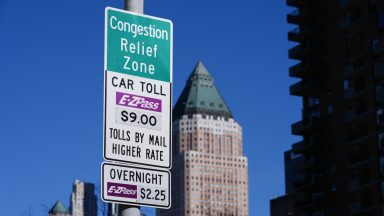
In a bold proclamation on social media, President Donald Trump has declared himself the ?King? and asserts he has put an end to New York City?s contentious congestion pricing initiative, which has faced criticism for its increasing costs. This announcement comes at a time when many are concerned about affordability and accessibility in urban transportation.
On Wednesday, following a communication from his transportation secretary, Sean Duffy, to New York Governor Kathy Hochul, it was revealed that the transportation department?s agreement with the state regarding the new congestion pricing scheme for Manhattan has been terminated. In response, Trump took to Truth Social to declare:
?CONGESTION PRICING IS DEAD. Manhattan, and all of New York, is SAVED. LONG LIVE THE KING!? This statement has raised eyebrows and prompted discussions about the implications of such a claim.
Despite Trump’s assertive declaration, the reality of whether he and his administration can effectively dismantle the toll program remains ambiguous. The public is left wondering about the future of these tolls and the feasibility of Trump fulfilling his promise. For a deeper understanding, delve into the details surrounding the tolls and assess the likelihood of the President’s ability to halt this initiative.
Understanding the Cost Structure of NYC?s Congestion Toll Program
The congestion pricing program, which officially commenced on January 5, introduces a $9 toll for vehicles entering the bustling areas of Lower and Midtown Manhattan, with a reduced overnight charge of $2.25. It’s important to note that drivers in standard passenger vehicles incur this toll once per day upon entering the designated Congestion Relief Zone. Commercial vehicles, including trucks and buses, face higher fees that range from $14.40 to $21.60 for each entry into this zone, significantly impacting logistics and transportation costs.
In addition to standard vehicles, motorcyclists are subjected to a toll of $4.50 during peak hours and a lower rate of $1.05 overnight, again applied once per day. This comprehensive toll structure is designed to mitigate traffic congestion while generating revenue for urban infrastructure improvements.
Identifying the Locations of NYC?s Congestion Tolls
As per the information available on the NYC 311 website, vehicles entering the Congestion Relief Zone will incur charges. This area encompasses local streets and avenues in Manhattan south of and including 60th Street, marking a significant geographical focus for the tolling initiative. Understanding these locations is crucial for drivers to navigate the city efficiently while avoiding unexpected charges.
Examining the Possibility of President Trump Halting NYC Congestion Pricing
Trump?s provocative post has elicited a mixed response from the public, with some individuals celebrating his assertive stance and others vigorously opposing it. The overarching question that remains is how much authority the ?King? truly possesses to uphold his declaration and whether it will translate into tangible action against the congestion pricing.
Before his presidential campaign, Trump made a commitment to ?terminate? congestion pricing, which has led to mounting pressure from local congressional representatives to act on this promise. However, any efforts to dismantle the program are likely to provoke a legal confrontation, as both New York State and the MTA are prepared to initiate lawsuits to defend the implementation of the tolls.
During a press conference held on Wednesday, Governor Hochul addressed Trump?s ?long live the king? remark shared on social media, emphasizing the importance of state sovereignty and governance.
?I?m here to say, New York hasn?t labored under a king in over 250 years, and we are not, we sure as hell are not gonna start now. The streets of the city where battles were fought, we stood up to a king and we won then. In case you don?t know New Yorkers, we?re in a fight, we do not back down ? not now, not ever,? Hochul asserted, reinforcing the resilience of New Yorkers.
Donald Trump isn’t a “king” and we won’t let him use New Yorkers as roadkill on his revenge tour.
We?ll see him in court. pic.twitter.com/kVB43hbjQu
? Governor Kathy Hochul (@GovKathyHochul) February 19, 2025
Exploring Congestion Toll Initiatives in Other Major Cities
New York City is pioneering congestion pricing as the first city in the United States to adopt such a program. However, various other global cities, including London, Stockholm, Milan, and Singapore, have successfully implemented similar tolling systems for years. These cities serve as case studies for the potential impact and effectiveness of congestion pricing in managing urban traffic challenges.






